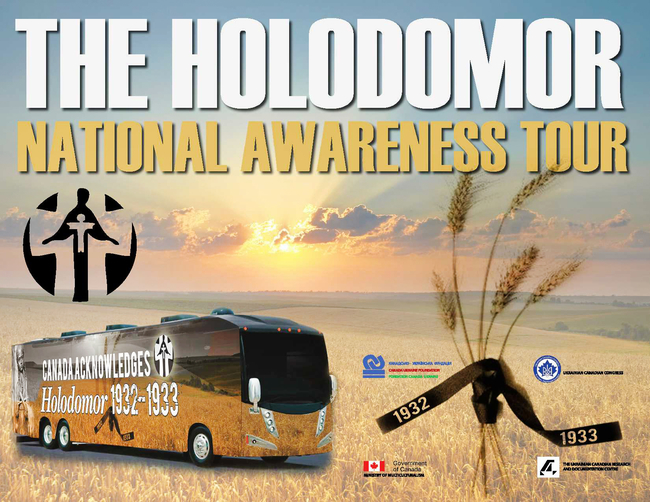Mobile classroom
It is the fourth month that the Holodomor National Awareness bus has been touring Canada to tell about the 1932-1933 tragic events in Ukraine
The organizers of the Holodomor National Awareness Tour say the very appearance of their bus (mobile classroom) is informative and makes people turn around, and when they come in and see the exhibits, most of them cannot hold back tears.
The project is the result of a joint effort of four organizations: the Canada Ukraine Foundation (the project founder), the Ukrainian Canadian Congress, the Ukrainian Canadian Research and Documentation Centre, and the Holodomor Research and Educational Consortium. It was funded by the central and provincial governments as well as by way of private contributions.
It is a 21st-century museum that employs cutting-edge multimedia technologies, artfully displays historical facts, and takes an individual and dynamic approach. The goal is to make young visitors take a keen interest in and not remain indifferent to the lessons of history. In the first year, the Holodomor Mobile Classroom is going to visit schools, festivals, and mainstream events in Ontario. In the next few years, it will make a tour of the country to put the idea across to at least 7,000 students. According to campaign organizers, the tour will promote understanding the consequences of hatred and discrimination as well as the values of freedom, democracy, human rights, and the rule of law through the lens of the Holodomor.
The Day got in touch with Bohdan ONYSCHUK, Holodomor National Awareness Tour project manager, the immediate Past Chair of the Canada Ukraine Foundation, who told us about the inception and goal of this initiative, the particularities of its implementation, the impressions of Canadians, and the project’s prospects.
“We hit upon the idea of a project in January 2014, and the Canada Ukraine Foundation applied for Canadian government funding. This application called for equipping a big bus with state-of-the-art audio and video appliances and for a three-year tour of Canada in order to tell the Canadian public about the Holodomor and its role in the history of Ukraine and the world. The Canadian government took on half the project expenses, and the tour was launched in January 2015. The government of Ontario awarded us a $750,000-grant for educational equipment,” Bohdan ONYSCHUK says. “This idea belonged to my good friend Denny Dzerowicz, an experienced exhibition and museum expert, who shared it with me as chair of the Canada Ukraine Foundation. Our foundation turned to the Ukrainian Canadian Research and Documentation Centre (which made Harvest of Despair, a well-known award-winning documentary film), Alberta University’s Holodomor Research and Educational Consortium, and the Ukrainian Canadian Congress, which also joined as partners. This is how the Holodomor National Awareness Tour was launched.
“It was first intended to establish a standard-type Holodomor museum in Canada, but the 21st century is setting new requirements – “to put the concept across to people” as interestingly and accessibly as possible. This particularly applies to schoolchildren because the topic contains history and its important lessons. So, we updated and adapted our strategy to the private sector and bring this information to the broad circles of society. An overcrowded bus is really the best way to reach the largest number of people in the shortest term and in the most effective manner, especially taking into account that it was an act of genocide, which the Soviet Union was hiding for over 60 years, and the West was unaware of it. Many have never heard the word ‘Holodomor,’ let alone know how to pronounce it correctly and what it means.”

THE HOLODOMOR AWARENESS TOUR’S MOBILE MUSEUM IS A BUS EQUIPPED WITH STATE-OF-THE-ART MULTIMEDIA TECHNOLOGIES
In the words of Onyschuk, the project’s aim is to acquaint students at Canadian secondary and higher educational institutions with the 1932-1933 genocidal Holodomor and Stalin’s intention to eliminate the Ukrainian nation, and to promote, via this history lesson, Canadian national values and such things as democracy, tolerance, pluralism, and human rights in today’s world. This will broaden the outlook horizons of young people, teach them to resist hatred and intolerance (be it an individual or governments), and help implement the principles of humaneness, which will knit together people of all nationalities and their histories and thus forestall repetition of those atrocities.
“When passers-by see this ‘tour on wheels,’ they get immediately interested in and intrigued about the project’s essence. The bus’s outer design attracts a great deal of attention, while the facts and, what is more, eyewitness accounts move Canadians to tears,” the interviewee continues. “The Mobile Classroom is 40 feet [about 13 meters. – Ed.] long and has three slide-door sides. Two sides have 34 seats and one, a video wall, is equipped with 12 flat TV screens, which show films and documentary fragments. At first, it is a few short (15-20-minute-long) videos for general audiences. We show such films as Harvest of Despair, The Soviet Story, Genocide Revealed, Voices of Survivors, with six films, including Food as a Weapon, UN Convention on Genocide and the Ukraine Famine, to follow. This is followed by an interactive educational module for senior graders. First the 12 screens show the main historical facts about the Holodomor, then a number of key Holodomor-time documents, decrees, and newspaper artifacts, coupled with the evidence of survivors. Then students can go deeper into the aspects they are interested in by means of additional gadgets. This is a nice practical case study for students, which allows them to take a critical look at the tragedy and think about how to ward off this kind of atrocities in the contemporary world.”
The project organizers say that, as the Holodomor National Awareness Tour’s educational component has not yet been finished, there have been no real lessons in schools so far. But the Mobile Classroom visited Washington to attend the unveiling of a Holodomor memorial in November and Ottawa during the ribbon-cutting ceremony on Parliament Hill. It also visited Queen’s Park and at the Legislative Assembly during the Holodomor Awareness Week, and then Mississauga, Ontario.
“We have only one bus now, but we hope to get another one which we will surely need in the next three years, taking into account the vast territories and a large number of people to deal with,” Onyschuk adds. “We are sure that the Holodomor’s history will continue to be revealed. Canadian and Ukrainian institutes and centers are doing research and gaining further information. This will allow exposing an immense injustice to the Ukrainian people on the part of the former Soviet regime, and we hope it will promote a better understanding of our past and of the complexes that must not repeat in the future. It is very important that our children must be aware of the importance of a democratic and tolerant civil society, human rights, and, above all, the inalienable right of every individual to life, freedom, and equality. We would like to extend the Holodomor National Awareness Tour by adding more videos for public view and setting up more educational modules for different age groups in order to reach a wider audience. The Holodomor information must be spread and studied all over the world. This was Stalin’s most hushed-up genocide which must no longer remain a secret now.”
The organizers also say the project is planning to raise another $700,000 to be able to continue not only until 2018, but also further on. The Canada Ukraine Foundation welcomes small and big donations, which can be sent to the CUF’s website http://www.cufoundation.ca./donate.
The incredible story of an overseas museum bus should be an example for Ukraine to follow. The more extensive knowledge of our own history is a key factor in the shaping of a high political culture and the power of analysis. Like never before, Ukraine is in need of humanitarian policy, especially on the territories that require not only an economic, but also a cultural modernization. New-level museums like this – with a modern and accessible approach – should tour eastern Ukraine, explaining the Holodomor, the making of Ukrainian statehood, the authenticity of Ukrainian culture, and other historical issues.
Newspaper output №:
№6, (2016)Section
Society





